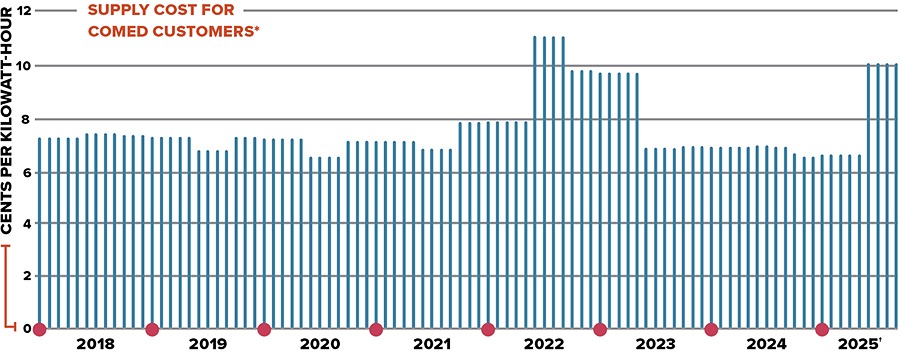Electricity costs for many people in the Chicago area were up noticeably this summer — 10 to 15 percent from last year, on average, according to ComEd. Why? And what can be done about it? To get some answers, Chicago talked with Sarah Moskowitz, executive director of the Chicago-based Citizens Utility Board, an advocacy group for electric and gas consumers that was created by state legislation in 1983. Spoiler alert: It will be at least another year before you get any relief.
On the most basic level, why are our electricity prices spiking?
There are a lot of reasons, but most immediately the fact that our regional grid operator, PJM Interconnection, ran an auction for capacity that yielded record high prices.
You’re talking about the annual auction in which power generators bid for the right to provide our grid’s capacity — that is, for ensuring we have enough electricity to meet peak needs.
Here in Illinois, we’re a restructured state, which means that state regulators only oversee part of our utility costs — the cost of the delivery of the energy to your home. That’s the part that ComEd makes its money off. The actual cost of the juice itself is set by the wholesale regional market run by PJM. That auction took place about a year ago, and the increased rate went into effect June 1.
So you’re saying the high prices aren’t really ComEd’s fault. Rather, the capacity cost is to blame. Why has that increased?
The fact that we’re facing unprecedented electric demand for the first time in 20 years is definitely a factor. Before now, demand had been relatively flat because of increased efficiency.
Efficiency meaning LED lights, weatherized buildings, more efficient appliances, and the like. At the same time, though, there are more and more electric vehicles on the road and more things running on electricity instead of gas, which might be good for the environment but raises demand, right? Aren’t the data centers that are being built to process AI also increasing capacity needs manyfold?
Yes, electrification of industry and transportation and, in a large way, the introduction of these energy-guzzling data centers have resulted in much higher forecasts for electric need. Experts can disagree on how those forecasts are conducted, and we suspect that they could be overinflated, which exacerbates a perceived supply crunch that leads to these higher auction prices. But it’s true that the demand for electricity is going up in a way that we have not ever seen. Some of these data centers can use the same amount of electricity as a medium-size city, and our markets and our market rules were not developed to deal with that kind of challenge.
High Energy
Electricity prices have risen to their highest levels since the summer of 2022, when energy costs jumped following a winter cold snap in the South.

*Excludes ComEd’s delivery charge. † Through September.
This overall increased capacity demand for our region then trickles down to regular customers as higher power bills?
Yes, and that was made even worse this summer because of how hot it was. So it wasn’t just the price per kilowatt that went up; people’s usage was out of sight because you needed air conditioning.
Illinois’s Climate and Equitable Jobs Act says we have to phase out fossil fuels by 2045. But if we close coal and natural gas plants, how is it possible to meet this surge in demand that’s expected to continue? Can it be done with renewables like solar and wind?
Well, in northern Illinois, we’re not as bad off as some areas because we have so much nuclear generation, which doesn’t emit carbon emissions. But yeah, this is a challenge. When CEJA was written, we did not see this on the horizon. CEJA included a provision mandating state regulators — the Illinois Power Agency, the Illinois Commerce Commission, and the Illinois EPA — to conduct a study to ensure resource adequacy, and they do have the authority to push back those closure dates, if deemed necessary. That study is underway right now. Meanwhile, there’s a lot that we can do, especially in terms of bringing battery storage online, that can help. A lot of times the capacity being built is really only to meet our needs during a few peak hours every year. So batteries can store excess power generated when prices are cheap, like wind power overnight, and be deployed when demand spikes.
“Unfortunately, the capacity auction setting next summer’s prices has already happened, and it’s going to be a little higher.”
So more storage will decrease needed capacity, which will then decrease our bills?
Getting more battery storage online quickly can help prevent future capacity cost price spikes. Unfortunately, the capacity auction setting next summer’s prices has already happened, and it’s going to be a little higher. But going forward, hopefully, we ease that supply-demand crunch. There are other low-cost approaches to meeting our energy needs that, now that we are in this crunch, are getting more attention — things like demand response, which is incentivizing electricity users to shift their usage to off-peak times. Traditionally, data centers have said that they can’t do that, that they need to be 100 percent on 100 percent of the time. The AI technology is so new that these technologies will get better and will become more efficient as time goes by. It’s not like, “Don’t worry about it, technology will get us out of this issue,” but overstating the emergency plays into the hands of those entities that want prices to be high. That would be the fossil fuel plant owners.
The Trump administration is quickly phasing out tax credits for renewable energy. What does that do to the outlook for renewables in Illinois?
Listen, renewables are a low-cost resource. Unlike other forms of electricity generation, renewables don’t require a fuel that is itself subject to market fluctuations and volatile prices. Renewables can be deployed much more quickly than a gas-fired power plant, and much, much more quickly than a nuclear power plant. It’s a shame that the renewable industry has received the setback just at this time when we need to get as much new electricity on the system as possible.
Is there anything in the short term that consumers can do to help control their bills?
ComEd customers do have the option of signing up for a real-time pricing rate, which doesn’t work for everybody, but it works for a lot of people. I’m a happy hourly pricing customer: I pay the market rate for electricity, and I just curb my usage at peak times.
Now that they will no longer be able to get the residential federal tax credit after this year, is there any point in consumers considering solar to lower their bills?
The loss of that tax credit will just mean that the payback period for your solar panels will be longer, but they will pay back. In the long run, you will benefit, but the upfront costs will be harder to recoup.



